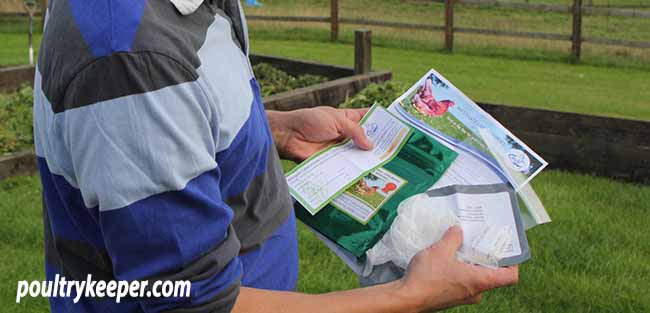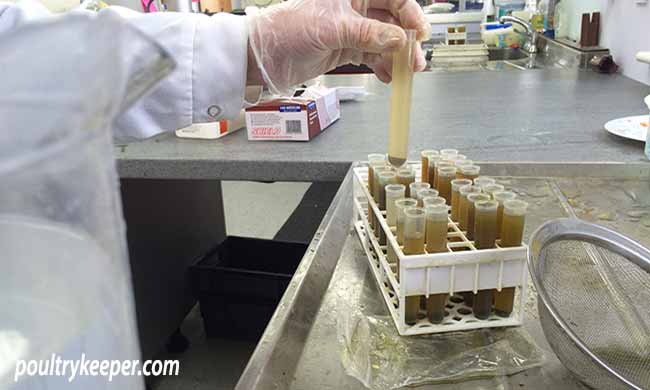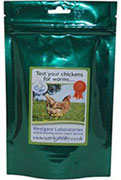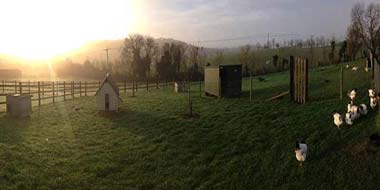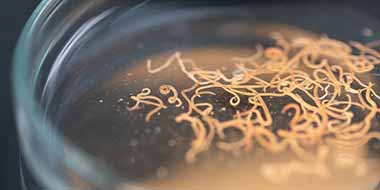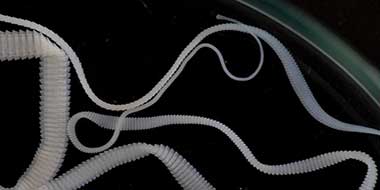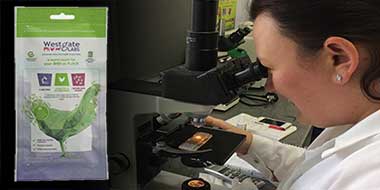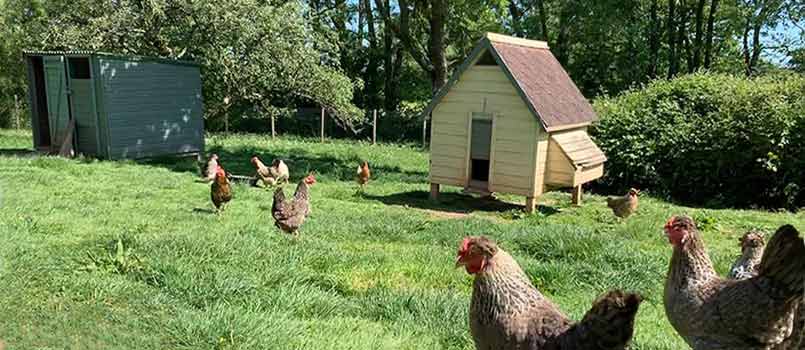
Worming Chickens
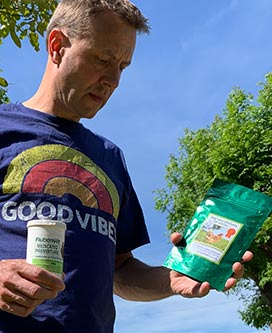
This in-depth guide will tell you everything you need to know about worming chickens. Most of the information also applies to other poultry but there is a separate guide for worming ducks here.
These days, worming chickens is a straightforward process; however, with drug resistance in the news and concerns about the use of drugs in food-producing animals, we should be cautious about routinely using medication.
It helps if we understand how our chickens get worms and when we should (or shouldn’t) be worming our chickens to avoid the indiscriminate use of medicines.
With proper husbandry, you can break the worms life cycle. Add in some natural remedies to make the environment less hospitable and some regular faecal egg counts (worm egg counts); you might be able to keep the worm burden low enough that you won’t need to resort to using a chemical wormer in the first place. So let’s begin!
Worms, Helminths & Endoparasites
Ectoparasites live externally, on the outside of your chickens – an example being lice or mites such as Northern Fowl mite.
Endoparasites, on the other hand, are located on the inside of your bird’s body. Endoparasites are called Helminths in the veterinary world, and it’s a term used to cover a wide range of internal parasites or ‘worms’ as we commonly call them.
The critical group of worms that concern us are called Nematodes. These worms inhabit various parts of the digestive tract. I have listed these below — one exception is Tapeworms which are part of a group called Cestodes and can occasionally be a problem for our chickens.
The links below take you to more information about a particular kind of worm. Perhaps you know which type infects your chickens already and would like to jump straight to that page to learn more about them.
The following types of worms can infect poultry:
- Hairworm: Found in the crop, oesophagus, proventriculus and intestine, also called Capillaria.
- Large Roundworm: Found in the bird’s digestive system.
- Gizzard worm: Found in the gizzard, mainly in geese. A common problem for goslings.
- Tapeworm: Uncommon, found in the intestine.
- Gapeworm: Found in the trachea and lungs.
- Caecal worm: Cause little damage but transmit blackhead to Turkeys.
Worming chickens, when infected, is essential because most of these worms can cause severe damage and eventually death.
The life-cycle of poultry worms
How do chickens get worms?
There are two known ways in which chickens can pick up worms and worm eggs:
Directly = from the ground/floor
Indirectly = via an intermediate host such as an earthworm or snail which have eaten the eggs.
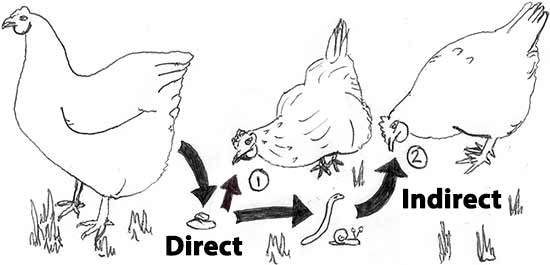
Direct life-cycle:
Worm eggs are expelled from an infected bird in droppings by the thousands. These eggs sit on the ground. They can survive for anything up to a year before they are picked up by birds foraging/feeding.
Large roundworms, gizzard worms (that affects geese), hairworms and caecal worms follow a direct life cycle. Hairworms can also have an indirect life cycle.
Indirect life-cycle:
Worm eggs are expelled from an infected bird by the thousand in droppings, or in the case of gapeworm (found in the respiratory system), coughed up. Worm eggs are not infective at this stage.
Intermediate hosts, (such as earthworms, slugs, snails and centipedes) will eat these eggs and (you’ve guessed it) your chickens will eat the intermediate hosts together with the worm eggs they have ingested.
What is an intermediate host?
An intermediate host is an organism that carries an immature parasite such as an egg or larvae.
The parasite requires this host to develop and usually acts as a “stepping stone” for the parasite to reach its final host.
The larvae hatch inside your chickens, and the cycle repeats. Hairworms, gapeworms and tapeworms follow an indirect life-cycle although (as already mentioned) hairworms can follow a direct life-cycle as well.
So now we know how chickens get internal parasites, let’s look at how we know they are carrying internal parasites!
Signs & symptoms of worms
How to recognise a worm problem
You can regularly inspect droppings (for example, when cleaning chicken coops out), although there aren’t always worms present unless there is a significant infection.
Many health problems that occur can be related to internal parasites of some sort. It is vital to check for worms regularly and worm when necessary and manage chicken houses, and runs correctly (more on this coming up under Good husbandry – preventing worms).
The most common symptoms are loss of weight / poor weight gain, increased feed consumption, pale yolk colour, diarrhoea and severe cases, anaemia (pale comb and wattles) and eventually mortality. There can be a lot of different symptoms of worms!
In the case of gapeworm, chickens will gasp for breath or ‘gape’ stretching their neck, as shown in the photo.
The following identification tips may be useful; however, the only definite way to be sure you don’t need to be worming chickens is to get a faeces sample (a worm egg count). Don’t worry; it’s not complicated.
I will cover that shortly.
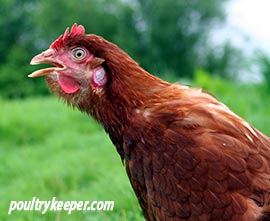
Poultry worm identification
Click on the drop-down below to learn how to identify the different kinds of poultry worms.
Please be aware that there are some photos of droppings and worms found during post-mortem that aren’t particularly nice.
Hairworms
As the name suggests are skinny. They are up to 1.5cm long but are hard to see with the naked eye. Typically, in a post-mortem, intestinal scrapings will be mixed with water in a petri-dish, and the thin white threads viewed against a black background.
Roundworms
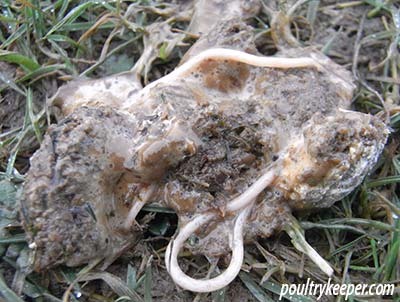 Roundworms are the easiest worm to spot, although there are often only a few adult worms in the small intestine, up to 8cm long.
Roundworms are the easiest worm to spot, although there are often only a few adult worms in the small intestine, up to 8cm long.
Sorry to say this, but they look just like spaghetti.
I took this first photo on the second day of administering Flubenvet wormer to a group of hens.
They not only cause damage but also take nutrients, and their waste releases toxins. After worming chickens with a lot of roundworms, there can be deaths because of the number of toxins released into the body.
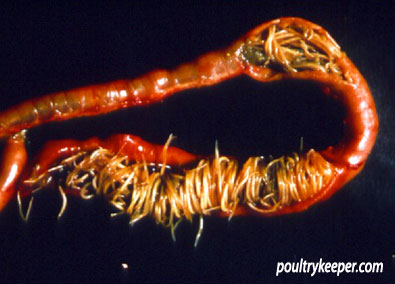 In vast numbers, roundworms impact (block) the gut.
In vast numbers, roundworms impact (block) the gut.
The next photograph (courtesy of Elanco) shows this impaction during a post mortem; as you can see, the gut is full of roundworms.
You can imagine the damage they cause and why it’s crucial to test for worms regularly.
Gizzard worms
You can find these in geese after death. Goslings raised on pasture with older geese are particularly vulnerable. They will stop growing and slowly waste away.
Take the gizzard and swill it around in a jam jar full of water. Hold it up to the light, and you will usually see thin gizzard worms around 2cm long coming away from the mucous lining.
Weight loss is often the first sign. Handle goslings regularly (ideally weigh them) and worm them if they are not gaining weight or start to lose weight.
Tapeworm
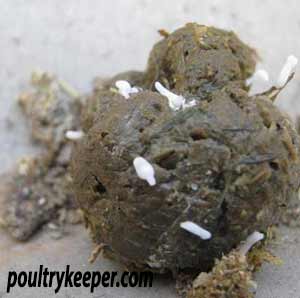 Tapeworms are very small, reaching 3-4mm long and are hard to spot due to their size.
Tapeworms are very small, reaching 3-4mm long and are hard to spot due to their size.
White Tapeworm segments that are shed and deposited in droppings are much easier to spot.
The photo right (courtesy of chickenvet) shows a dropping with tapeworm segments visible.
Gapeworm
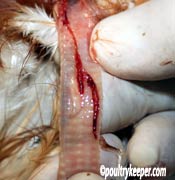 Gapeworms are red, up to 2cm long and Y-shaped. This shape is the male and female joined together (how romantic!)
Gapeworms are red, up to 2cm long and Y-shaped. This shape is the male and female joined together (how romantic!)
The photo shows a post mortem finding of gapeworms in the trachea (the windpipe) of the respiratory system.
You may see chickens gasping for breath (gaping), as shown earlier in this guide.
They are much more common in pheasants, and your chickens are more likely to pick up gapeworm if they free range on land that has pheasants visiting.
Caecal worms
Caecal worms are grey to white and up to 1.5cm long. They are S-shaped. Worm eggs are too small to be visible with the naked eye and have to be identified under a microscope.
The damage caused by worms will be in part of the digestive tract (or respiratory tract in the case of gapeworm) where the parasites live. Typically, infections cause anaemia and haemorrhaging. As shown above for roundworms, in large numbers, they can impact (block) the gut. Worms cause damage and take nutrients from the body. Their waste also releases toxins into the body.
Diagnosing worms in chickens
How do we know if chickens have worms?
Getting a ‘worm egg count‘ (a faecal sample, often just called a worm count) is the way a vet would diagnose a case of worms. It used to be quite a costly exercise.
Thankfully, times are changing, and you don’t have to go to your vet to get this done anymore; there are postal worm count kits available for chickens.
Getting A
Worm Egg Count
Using a worm egg count kit is relatively straightforward. There are gloves, a collection bag for samples and a pre-paid envelope. The worm count takes place in a lab under a microscope, and the result is returned by email advising you of the number of eggs and whether you need to worm your chickens.
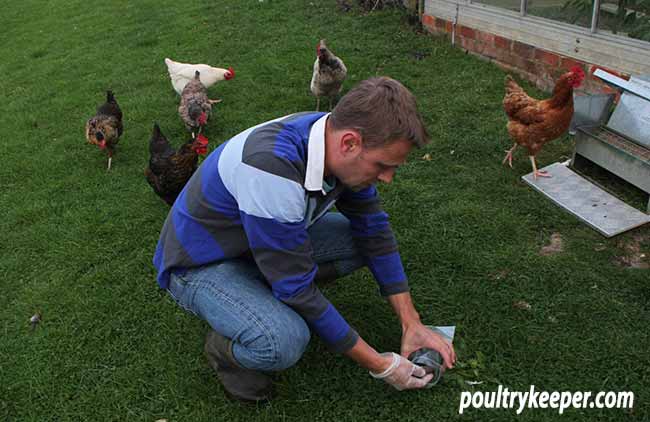
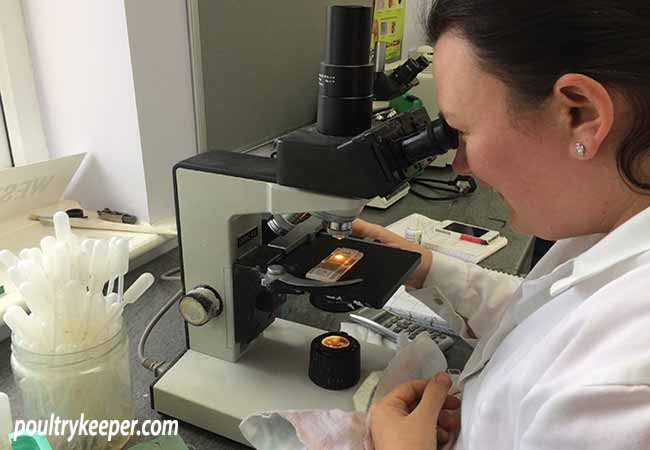
You need to submit some fresh droppings from as many of your birds as possible in your flock. Try to include Caecal droppings too – these are yellow-brown foamy coloured dropping, expelled roughly every 24 hours.
A worm egg count kit contains everything you need to collect and send off a sample to the lab.
Results are sent to you by email the same day after they have examined the samples under the microscope and will tell you what was present in the droppings and whether to worm or not.
I like this approach because I can follow a more natural method to worming chickens, and be reassured that it’s working (or not). It helps me sleep at night, anyway!
So let’s look at how we can help our chickens to get a negative test.
Good husbandry: preventing worms
How to make life difficult for internal parasites
Here are some tips for making life more difficult for worms in chickens. Prevention is always easier than cure, so follow proper husbandry techniques, and you’ll see far fewer worm problems.
Worm eggs cannot mature in:
- An arid atmosphere, they need some humidity to develop.
- Temperatures below 10°C. They will lie dormant in cold temperatures.
- Temperatures above 34°C. They will start to die off at high temperature.
- In the absence of oxygen. They need this to start development.
Worm eggs thrive in wet, warm, muddy areas. Remove muddy areas such as those found by pop-holes by creating hard standing or free-draining gravel.
Worm eggs cannot develop when the temperature is below 10˚C. As the temperature increases, their numbers can proliferate suddenly. Testing for parasites in springtime is essential; it is a critical time of year.
Eggs and larvae soon dry out when exposed to sunlight and air. Whenever possible, you should rotate grazing pasture and when there is grass in a run, keep it cut short.
Tip: Pasture management
Worm eggs and larvae dry out quickly during dry weather. They are also destroyed by Ultra-violet Light (UV) from sunlight. Keep grass short and rotate pasture to help reduce the build-up of worms.
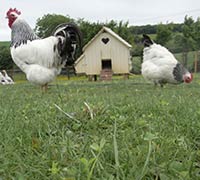
If you have a small (probably muddy) run, you might be cursing me talking about cutting the grass! The best solution, in this case, is to use sand or hardwood chips as a substrate (not bark chippings, this can cause Aspergillosis an infection caused by a type of fungus).
Change the run substrate annually, or when it gets mucky. When cleaning, a sanitising powder like Net-Tex Ground Sanitising Powder is useful. More on this coming up below under Natural worming methods.
Litter in poultry houses needs to be changed weekly to keep it fresh. Always ensure bedding is dry. Periodically, I will use a disinfectant to clean the house before replacing the litter. This will destroy worm eggs and larvae.
Healthy chickens build resistance to internal parasites as they mature. A low background level of worms is quite normal, but if their worm burden grows, it will start to affect the bird’s health. This can happen quite suddenly with overcrowding or if birds become stressed in some way.
Young birds have not acquired resistance to worms, so it is better not to mix different age groups. If you need to add point-of-lay chickens to an established flock, you will be stressing them as well as introducing birds with less resistance to worms. I usually test about a month after adding any new birds on top of my normal standard prevention and testing measures.
Natural methods of worming chickens
How to control worms organically
Some natural/organic products MAY help to prevent or reduce the parasite burden. There are no tests published (that I’ve been able to find) that prove or disprove natural worming products for chickens.
I discovered why. Regulation in the UK and EU prevent manufacturers of herbal worming products from publishing results or even calling them worming products. I believe this is why some are called ‘gut sanitisers’ and have names that might suggest they are wormers (Worm-R or Verm-X, for example).
Worming chickens with Apple Cider Vinegar or Diatomaceous Earth often comes up as a topic discussed in forums.
Natural methods work by making the environment inside the gut unpleasant for parasites and harder for them to reproduce. Most boost the health of the bird to help them withstand the parasite challenges. They take time to build up in the body and are best suited to preventing rather than curing worms.
Some organic products you can buy like Diatomaceous Earth (DE) mixed in with chicken feed, Apple Cider Vinegar (ACV) and even fresh crushed Garlic (both usually given in water) are commonly thought to be suitable as health supplements for chickens so they can only help.
Garlic is thought by some to stop eggs of some parasites from developing in the gut. Diatomaceous Earth (DE) contains high levels of calcium, and we know that worms don’t thrive when there is a lot of calcium present in the diet.
I have a few favourites that I use regularly, but there are a lot of others on the market to try.
Before chemical wormers were on the market, garlic cloves crushed into the water was often the remedy for worming chickens suggested in old poultry books, but then again there was nothing else they could use back then. Flocks were smaller, and pastures were more extensive, making rotation easier. There were probably fewer problems in those days.
Sanitising powders such as Net-Tex Ground Sanitising Powder used on the floor of the coop and run absorbs moisture and oxygen from worm larvae and faeces where parasitic worm eggs would develop and mature.
Tip: Worming chickens naturally
Check your natural worming methods are working by getting a worm count regularly (at least during the spring and autumn). This way, you can be sure your chickens aren't carrying worms.
Verm-X is the market leader in herbal ‘gut sanitisers’ or ‘intestinal hygiene’ products. Since it’s a herbal product, it is also suitable for use in organic production.
A lot of companies selling Verm-X call it a wormer, however, Verm-X is a herbal product, not a licensed medicine.
UK and EU law says that non-licensed medicinal products, (such as herbal wormers) must not use associated names (like ‘wormer’ or ‘anthelmintic’) which is why Verm-X do not use it on their packaging or website.
For clarification of the law, start here:
https://www.gov.uk/government/organisations/veterinary-medicines-directorate
The Verm-X website says: “Verm-X is a 100% natural, active formulation that helps restore and maintain gut vitality, a foundation for good animal health. We’ve harnessed a unique combination of herbs to cultivate a healthy digestive system – an effective alternative to using artificial chemicals.”
There is no mention of wormer!
I always get asked if natural worming works. Here’s my view:
A combination of good husbandry and natural products can prevent worms, and this is my preferred approach with my flock, STILL it must be supported with worm egg count testing at regular intervals to confirm it’s sufficient.
I no longer believe in worming chickens routinely unless I know there is a problem. It only adds to drug resistance problems.
I DO NOT think you should use natural methods of worming if your chickens already HAVE worms. None of the natural products has published scientific studies to show they can remove a worm burden.
Natural products take time to work so should be seen as a long-term strategy to support the health of your flock.
Even if some of these natural products don’t do much to discourage internal parasites, most can be beneficial to a chicken’s health, and we know that healthy chickens are less likely to suffer from an overload of worms.
Chemical wormers
How to treat chickens for worms
There are several different wormers available, and I provide information about these below. Depending on where you live, the legislation varies.
Remember this information aims to help you understand the available wormers, always read and follow the label. If in doubt, consult your veterinarian.
How often should chickens be wormed?
There’s no hard and fast rule because it depends on the environment in which you keep your chickens.
Before worm count kits became common, most backyard flocks were wormed at least twice per year in the spring and autumn with Flubenvet (in the UK).
These days, with concerns over drug resistance to avoid medicating unnecessarily, testing for worms instead of ‘routine’ worming is (in my opinion) a better approach.
How often depends on what vets call the ‘infection pressure’ on your flock.
Ask yourself these questions:
- Has the ground had chickens on it for a long time, or have they been moved onto fresh pasture to break the life cycle?
- Do you keep a lot of chickens in a small area?
- Is there mud in your chicken run? (Worms thrive in muddy areas).
- What are the local weather conditions? Worms eggs and larvae need some humidity and will lie dormant below 10°C, and in hot (above 34°C), dry conditions, they die. They will dry up when exposed to air and sunlight during warm weather spells.
- Do you have other natural organic worming methods in place to help reduce the worm burden?
As a minimum, if the risk of worms in your flock is low and you don’t suspect problems, I suggest a worm count in the spring, as the humidity rises with the temperature holding above 10°C for a few weeks (usually April in the UK) and during the autumn (September in the UK).
Can you eat eggs when chickens are wormed?
It depends on the medication. Licenced anthelmintics (wormers) will tell you the withdrawal period for eggs and meat on the label.
For non-licensed wormers, your vet will advise you on a suitable withdrawal period. There is more on withdrawal periods later in this guide.
Flubendazole and Flubenvet (licenced wormers in the UK) have no egg withdrawal period when used at the recommended dose for seven days.
Always follow the advice on the manufacturer’s label.
Is it a "chicken wormer" or a "chicken dewormer"?
Is it a chicken wormer or a chicken dewormer? For many years I have wondered what is right and chicken anthelmintics is far too “veterinary” for a backyard poultry website!
I have seen datasheets, technical papers and books published from respected authors using both (but not mixing them). It seems that dewormer is more common in North America.
I have mostly chosen to use chicken wormer on poultrykeeper, but the jury is still out as to which is correct.
Medications (active ingredients) used in wormers
Active ingredient
Brand Names*
Effective against
Approved in:
Flubendazole
Flubenvet
Flubendazole
Solubenol
Filmabend
Roundworm
Gapeworm
Capillary Worm
Caecal Worm
UK & Ireland
Fenbendazole
Safe-Guard Aquasol
Panacur
Roundworm
Gapeworm
Some Capillary Worm
Caecal Worm
Tapeworm
EU
US
Ivermectin
Drench or injectable
Ivomec
Roundworm
Gapeworm
Capillary Worm
Caecal Worm
??
Ivermectin
Spot-on / pour-on
Harka-mectin
Roundworm
Gapeworm
Capillary Worm
??
Levamisol
Prohibit
Roundworm
Gapeworm
Capillary Worm
Caecal Worm
Australia
Piperazine
Wazine**
Roundworm
Gapeworm
Capillary Worm
Caecal Worm
Tapeworm
Australia and Canada
(withdrawn in US)
Hygromycin B***
Hygromix
Rooster Booster
Roundworm
Capillary Worm
Caecal Worm
US
* These are some of the common brand names I have come across. Would you please let me know if I’ve missed something from your country? I want to improve this table!
** Wazine is mentioned as the only wormer in the US in many articles and books I read when researching this article. Wazine 17 and 34 (containing Piperazine) were voluntarily withdrawn (sometime in 2019, I didn’t find the exact date):
*** Hygromycin-B is an antibiotic, so if you are worried about using antibiotics in backyard poultry, it would be better to use an alternative. It comes under the VFD classification (more on this below), so a vet must prescribe it.
Wormers in the UK
The only licensed products for worming chickens, turkeys and geese in the UK contain the drug Flubendazole. The brand names are Flubenvet (produced by Elanco) and Flubendazole (produced by Kernfarm Livestock Phama) and are administered in feed. Flubendazole 1% was released in 2018 and (looking at the label) seems to be a copy of 60g Flubenvet 1%.
There are Flubendazole based products that can be added to drinking water, although they are better suited to commercial farms because the amounts you would need to add to small amounts of drinking water are tiny.
Wormers in the US
There is a LOT of incorrect information online and in print. So much has changed over the last few years.
The only Food and Drug Administration (FDA) approved Over The Counter medication (OTC) is Safeguard Aquasol. It can be verified here. The datasheet shows it has approval for chickens/layers, and the product type is OTC. You may find some websites saying it doesn’t have authorisation for laying hens; however, check the ‘supporting documents’ tab and you will see a supplement that added laying hens in May 2018.
Hygromix (containing Hygromycin-B) is licensed; however, it is an antibiotic and comes under the Veterinary Feed Directive (VFD). US law says you must have written authorisation (sorry, using ‘s’ instead of ‘z’ with my British spelling!) to use animal feed containing specified antibiotics per FDA-approved directions for use.
Only your veterinary surgeon can provide this. You can verify this here. Again, check the product type and you’ll see it’s VFD.
If you are worried about the use of antibiotics in backyard poultry like me, it is probably best avoided, especially considering there is an over the counter alternative.
Note that Wazine 17 and 34 (containing the active ingredient piperazine) was voluntarily withdrawn in 2019. You can verify that here under ‘Status’ at the top of the page. Most books and articles you find will tell you Wazine is approved but check the date and you will find out it was before it was withdrawn.
Non-licenced wormers
The number of licensed wormers available is limited in most countries. Obtaining a license for medication for food-producing animals has a considerable cost attached.
Sometimes an approved drug that works against a particular parasite isn’t licensed in that country, or the vet doesn’t have the licensed product on their shelf. However, they do have wormers designed for pets or other livestock available.
In the UK, a vet may prescribe these unlicensed products under what is known as their ‘clinical judgement’ if there isn’t a licensed alternative available. They prescribe ‘off-label’.
In North America, terminology can be slightly different. A vet prescribing medication that isn’t approved by the Food and Drug Administration (FDA) for worming chickens is known as ‘extra-label’. The Veterinary Feed Directive Act (VFD) in the States outlaws the off-label use of drugs without veterinarian direction.
Withdrawal periods
Different products require a different period to pass through the bird’s body.
For products licensed in your country, it’s quite simple; the label will tell you if there is a withdrawal period.
Remember, you must follow the label using the stated dose for the stated time for that to be true!
One example I’ve seen of people worming chickens incorrectly is where people say their birds don’t eat the medicated feed, so they suggest giving Flubenvet on a half a grape or similar treat to each bird ‘to make sure they have had a dose’.
Flubenvet is supposed to be mixed into poultry feed and given to birds over seven consecutive days. A large bird eats more food and receives a higher dose than a small bird.
They are getting the dose according to their weight (and gradually over seven days). Giving one large amount on a treat is not following the label and, (for all we know), residues could be above safe limits in eggs.
If your birds don’t eat the medicated feed, make sure you have removed all other treats. After a day, they will be hungry and will eat the medicated feed rather than starve.
Egg withdrawal for unlicensed products
If a product isn’t licensed, there is usually no dose or withdrawal period suggested on the label for poultry.
Your vet will need to advise you on the egg withdrawal period for unlicensed products they prescribe which by law (in the UK) has to be a minimum of seven days.
Wormers by brand name
Flubenvet (UK)
Containing the active ingredient Flubendazole
Flubenvet is one of two licensed in feed wormers for chickens, turkeys and geese in the UK. You need to mix it with your poultry feed for seven consecutive days and exclude other food to make sure your chickens get the required dose.
Flubendazole based products are not licensed to treat tapeworms. There appear to be conflicting opinions as to whether Flubendazole is effective. I would suggest seeking the advice of a poultry vet if tapeworms are a problem.
Which Flubenvet is right for you?
There are different size packs of Flubenvet available. It is also available in bags, pre-mixed with layers pellets. Depending on the size of your flock, one type might be better for you than another.
By far, the easiest way to administer Flubenvet is to buy a bag of pre-mixed Flubenvet with layers pellets. It is the best solution for most backyard flocks.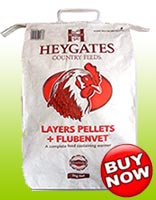
It is available in 5 and 20Kg bags, and you must give hens the medicated feed for seven days so you should measure how much your flock of hens will eat beforehand.
As a general rule of thumb 20Kg of feed is enough for 20 large chickens for one week but different breeds consume different amounts and consumption varies according to the time of year (in winter chickens eat more to keep warm).
Companies such as Marriages or Heygates supply Flubenvet layers pellets and can be bought at farm stores or online here.
Expect to pay £12-£13 for 20Kg, £6-£8 for 5Kg plus postage (which can be as much again) but remember to take into consideration the cost of a standard bag of feed (around £9-£10 for 20Kg) so this is usually cost-effective, and there is no fiddly mixing required.
This pack contains enough to medicate 20Kg feed which is enough to treat 20 large fowl.
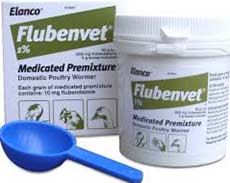
If you have a few hens, it comes with a plastic scoop (approx. 6g) for measuring out the amount so you don’t need accurate electronic scales as you would with the larger 240g Gamekeeper packs.
The sell-by date is usually at least 12 months. Expect to pay around £35 plus postage best found through an online search.
More information about this product can be found here on our Flubenvet 1% 60g page.
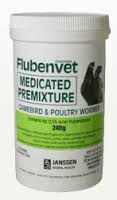 The ‘Gamekeeper pack’ and contains enough to medicate 100Kg of feed / enough to treat 100 large fowl.
The ‘Gamekeeper pack’ and contains enough to medicate 100Kg of feed / enough to treat 100 large fowl.
Useful if you have a large number of hens to treat (but I would still consider Flubenvet pre-mixed with layers pellets). You will need accurate electronic scales to measure down to 0.1 grams. The best before date is usually at least 12 months.
Expect to pay around £75 plus postage. It is available from specialist suppliers. Try Bowden and Knights or The SPR Centre.
More information about this product can be found here on our Flubenvet 2.5% 240g page.
There is further information on worming chickens with Flubenvet on this page. The NOAH Compendium datasheet is available here.
Flubendazole (UK)
Containing the active ingredient Flubendazole
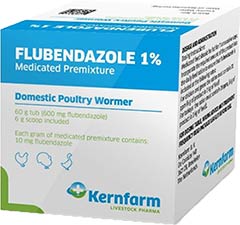 Just like Flubenvet, Flubendazole medicated premixture from Kernfarm Livestock Pharma is available as a 60g pack and includes 1% Flubendazole.
Just like Flubenvet, Flubendazole medicated premixture from Kernfarm Livestock Pharma is available as a 60g pack and includes 1% Flubendazole.
The pack will medicate 20kg of chicken feed (30kg of turkey feed) it comes with a 6g scoop so you can medicate 2Kg of chicken feed at a time. Give Flubendazole for seven consecutive days. There is a zero egg withdrawal period. Just like Flubenvet, it doesn’t have a license for tapeworms.
Safeguard Aquasol (US)
Containing the active ingredient Flubendazole
Safeguard Aquasol from Merck Animal Health is currently the only Food and Drug Administration (FDA) approved over the counter medication wormer in the US. (Note: Wazine was withdrawn, see my notes in ‘Wormers in the US‘ above).
Given in drinking water and your chickens must only have access to the medicated water for the five consecutive-day treatment period. There is no withdrawal period when used according to the label.
Other wormers
Solubenol and Filmabend (UK)
Containing the active ingredient Flubendazole
Solubenol and Filmabend are water-soluble wormers administered in drinking water for seven consecutive days, used for the treatment of worm infestations caused by large roundworm, caecal worm and capillaria worms.
Licensed for use in commercial farms, so will sometimes be in stock at your vet’s. Beware, it needs careful mixing and must be used in quite a short time by your hens.
Panacur Aqua Sol (UK)
Containing the active ingredient Fenbendazole
A 20% solution that is water-soluble. Administered for five consecutive days, it has no egg-withdrawal period.
At first, it looks attractive for backyard poultry keepers; however, the amount required for a small flock is so tiny, it’s only really a viable option for 50 birds or more.
Panacur Aqua Sol is licensed to treat Hair worms, Large Roundworm and Cecal worms but not gapeworms or tapeworms.
Prohibit (US), Levicur (UK) and other brand names
Containing the active ingredient Levamisole Hydrochloride
A single dose wormer licensed for cattle and sheep that is useful for geese. It is often in stock at vet’s and available following their prescription and advice.
Useful for worming geese suffering from gizzard worms since free-range geese will prefer to eat grass than a medicated feed containing Flubenvet!
Levamisole Hydrochloride is not licensed to kill tapeworms.
Ivomec, Harkamektin, & other brand names
Containing the active ingredient Ivermectin
Ivermectin based anti-parasite medication, effective against most worms, mites and some lice including scaly leg mite and Northern fowl mite.
Worming chickens with Ivermectin
Ivermectin pour-on/drops are popular, applied on the skin and can be purchased easily online.
Unlicensed for use in poultry so should only be used at the advice of your vet, but worming chickens with drops of Ivermectin on the skin is still quite popular in back yard flocks because of its many other uses.
Since it is unlicensed and there is no withdrawal period given on the label for hens laying eggs, your vet will advise of the withdrawal period. In the UK, the minimum withdrawal requirement is seven days.
I found a study7 on the depletion of ivermectin residues in eggs of hens, treated with ivermectin. It explains that during the trial, after the level of Ivermectin appearing in the eggs had reached a steady-state, once treatment stopped, the levels decreased below the limit of determination after four to five days.
It suggests that a seven day withdrawal period vets use is reasonable.
I have some further information on Ivermectin on this page.
The jam jar test
If you're curious like me, you may like to do this to see what comes out when you are worming chickens.
- Place a sheet of newspaper on the floor under the perches (weighted down on the edges to keep it in place). Collect the droppings overnight.
- Use a jam jar, partly filled with water and add the collected droppings.
- Shake the jar to separate the droppings.
- Inspect the contents by holding it up to the light to see if you can see any worms.
The prepatent period
When should you repeat the treatment?
Although a wormer should kill worms and their eggs that your birds are carrying, it does nothing for the eggs in the environment where your chickens are living.
The life-cycle (from egg to egg-laying adult) of poultry worms varies between 2 and 8 weeks depending on the species. This time is called the prepatent period.
If there is a bad infestation and you cannot treat your birds and move them to clean pasture, they will start to pick up worm eggs and get re-infected. It is for this reason that if you have well-used ground and a particularly bad worm problem, you may need to repeat treatment before these eggs develop into egg-laying adult worms producing thousands of eggs.
During the prepatent phase of infection, poultry can harbour lots of immature worms that are not laying eggs, so no eggs will be present in the droppings (or on a worm count).
Treatment should be repeated within this period (if you know the type of worm) or (if you don’t), 3 weeks after the end of the last treatment (2 weeks for geese) .
It very much depends on how your birds are kept and managed as to how many worms they will get. Infection may persist for many years, on well used ground but with good husbandry and regular worming when necessary, you often won’t have many probelms.
References
-
- NOAH Compendium. Flubenvet 1% medicated premixture Datasheet
- The Chicken Health Handbook by Gail Damerow
- Diseases of Free Range Poultry by Victoria Roberts.
- Keeping Geese – Breeds and Management by Chris Ashton
- Flubenvet worming brochure
- Food Animal Residue Avoidance and Depletion Species Website
- Keukens HJ, Kan CA, van Rhijn JA, et al. Ivermectin residues in eggs of laying hens and in muscle and liver of broilers after administration of feeds containing low levels of ivermectin, in Proceedings. EuroResidue IV Conf 2000;678–682
And my thanks to:
- Jeremy Chartier, University of Maine’s Poultry Service Provider training program.
- Elanco – for various photos
- Westgate Labs – Worm count photos and advice on testing.
- Chickenvet – Tapeworm segment photo

